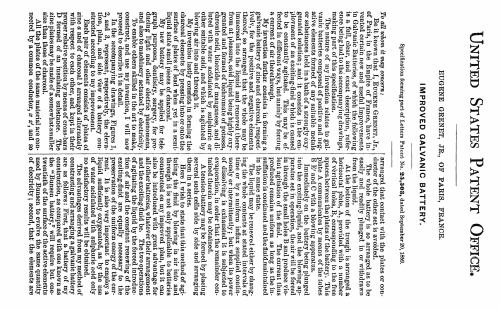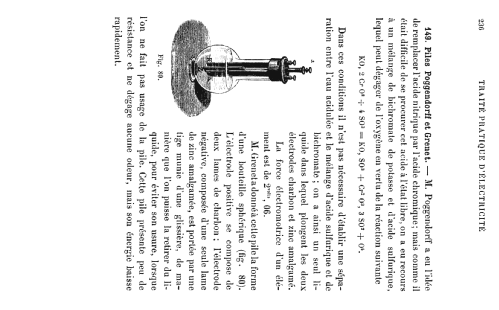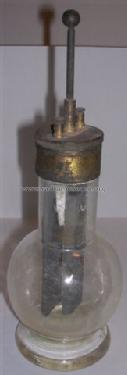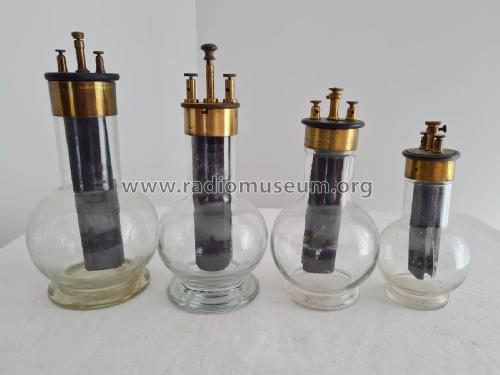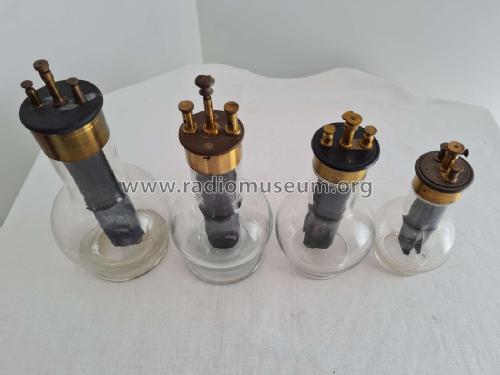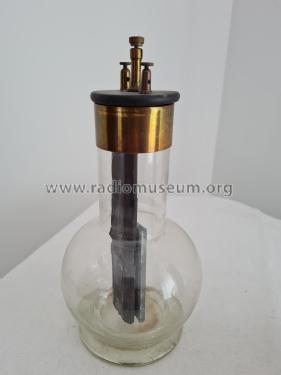Pile de Grenet (Pile Bichromate) - Chromic acid cell, Pila, Chromsäure-Element
Grenet, Eugène (fils); Paris
- Country
- France
- Manufacturer / Brand
- Grenet, Eugène (fils); Paris
- Year
- 1859 ??
- Category
- Power supply/conditioner or battery or charger
- Radiomuseum.org ID
- 82174
Click on the schematic thumbnail to request the schematic as a free document.
- Wave bands
- - without
- Power type and voltage
- Is a battery or storage battery / 2,06 Volt
- Loudspeaker
- - - No sound reproduction output.
- Material
- Various materials
- from Radiomuseum.org
- Model: Pile de Grenet - Chromic acid cell, Pila, Chromsäure-Element - Grenet, Eugène fils; Paris
- Shape
- Miscellaneous shapes - described under notes.
- Notes
-
La Pile de Grenet au bichromate de potasse, dite pile bouteille, a été développé basé sur la Pile Poggendorff de 1842, par M. Eugène Grenet vers 1850 environ.
M. Grenet a donné cette pile la forme d'une bouteille sphérique. L'électrode positive se compose de deux lames de charbon; l'électrode négative, composé d'une seule lame de zinc amalgamée, est portée par une tige munie d'une glissière.
Emile Barrault présenté une pile électrique système Grenet dans la Séance du 16 Juillet 1858 à la Société des Ingénieurs Civils. Un brevet a été publié en Septembre 1859 pour les piles système Grenet (États-Unis No. 25,503, voir documents)
La pile bouteille a été produit par des fabricants différentes dont Péricaud, Ducretet et Lejeune (Pile à Treuil) et beaucoup d'autres sociétés, jusqu'au début du 20ème siècle. Il a été encore ameloiré par M. Gaiffe (Pile Gaiffe 1er et 2e modèle).
Généralement, la pile Grenet était disponible en différentes tailles : 0.5, 0.75, 1.0, 1.5 et 2 litres, ainsi que de plus grandes tailles de 4 et 6 litres.
La force electromotrice d'un élément est nominalement de 2.06 V, mais varie entre 1.92 et 2.20 volts.
The Grenet cell uses diluted sulphuric acid as electrolyte and chromatic acid as depolariser. The substances were physically mixed together, eliminating the porous pot used by Poggendorff.
The positive electrode (cathode) consists of two carbon plates, with a zinc plate (negative or anode) positioned between them. Because of the tendency of the acid mixture to react with the zinc, a mechanism is provided to raise the zinc electrode clear of the acids when the cell is not in use. Current can be limited with a variable elevation of the zinc electrode, recuding the contact area.
The cell provides a nominal charge of 2.06 Volts. It proved popular with experimenters for many years due to its relatively high voltage, greater ability to produce a consistent current and lack of any fumes. This cell was preferred by Edison for his experiments with electricity.
Commonly referred to as chromic acid cell, it was also called bichromate cell. Chromatic acid being difficult to obtain on the market, a mixture of potassium bichromate and sulfuric acid was used to react to the required chomic acid.
Chemically, the action of the cell is presented by the following equation:
3Zn + K2Cr2O7 + 7H2SO4 = Cr2(SO4)3 + 7H2O + K2SO4 + 3ZnSO4
where the reduction reaction Cr2O7 2- + 5 H2O + 14 H+ + 6 e- ↔ 2 Cr(OH)6 3+ and an oxidation reaction 3 Zn <---> 3 Zn3+ + 6 e- can be summed to the redox reaction:
Cr2O7 2- + 3Zn + 5H2O + 14 H+ ↔ 2Cr(OH)6 3+ + 3Zn 3+
- Mentioned in
- Traité Pratique d'Électricité, Félix Lucas, 1892
- Literature/Schematics (1)
- US Patent Office, Patent No. 25,503, Sep. 1859
- Author
- Model page created by Rino Ferro † 2008. See "Data change" for further contributors.
- Other Models
-
Here you find 1 models, 1 with images and 1 with schematics for wireless sets etc. In French: TSF for Télégraphie sans fil.
All listed radios etc. from Grenet, Eugène (fils); Paris
Collections
The model Pile de Grenet (Pile Bichromate) - Chromic acid cell, Pila, Chromsäure-Element is part of the collections of the following members.

